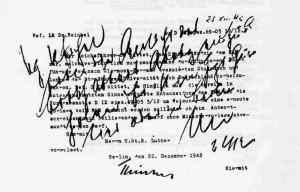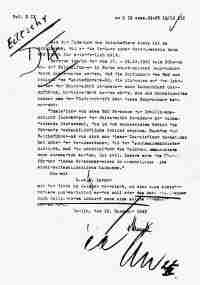TALKS BETWEEN REICHFUHRER HIMMLER
AND MINISTER FOR FOREIGN AFFAIRS VON RIBBENTROP
As early as June 1940, Reichsführer SS Heinrich Himmler, chief of the Gestapo and of the Police force of the Reich, later (1943) Minister of Interior, had settled the whole of his offices in France.
These offices were : the Military police force (ORPO), in charge of maintaining law and order, the Gendarmerie in the armies (Felsgendarmerie) and 2 SS formations under command of SS officers : the Security police (Sicherei Polizei), alias SIPO, and the Security service (Sicherei Dienst), or SD. In Paris, they were placed under the high authority of General SS Carl Oberg.
The two bodies SIPO and SD, joined together, formed the BDS (Befehlshaber Der Sicherheits Polizei Und Der Sicherheitsdienst), more commonly known under the name of GESTAPO (Geheimnis Staats Polizei), i.e. State security police.
The Gestapo was headed by colonel SS Helmut Knochen. He headed a number of region branches, each directed by a KDS (Kommandeur der SIPO und SD), who himself was in charge of organising local antennas.
In the "Free Zone", there was only a delegation of the Gestapo in Vichy, which was headed by captain SS Hugo Geissler. In November 1942, after the German invasion of Zone Sud, Geissler was appointed KDS in Vichy. Thus, he knew the area already. He set up an antenna in Clermont-Ferrand. The offices of the Gestapo antenna were located 2bis, avenue de Royat (Chamalières). Its prison was the former 92th RI* Headquarters in Clermont-Ferrand.
The Clermont-Ferrand antenna was directed by Paul Blumenkampf, assisted by his very powerful secretary Ursula Brandt.
We knew them soon: Blumenkampf played the jovial fellow. As for Ursula Brandt, she was soon nicknamed "the Panther", not that she was particularly cat-like (she was rather short indeed), but she wore a coat made of the skin of this animal, a coat which she never took of, even when the temperature reached 100°F. Blumenkampf and Ursula Brandt, as it appeared, had received special training in the techniques of group infiltration.
It is ascertained that, as early as the Armistice of 1940, the closing down of Strasbourg University and the return of 500 people "the intellectual elite of its teachers and students of German stock" to the Reich was "a matter of national interest "for Reichsführer SS Heinrich Himmler.
But Strasbourg University was located in Clermont-Ferrand, that is to say in Zone Sud, under the authority of the Vichy government : Himmler could not take any action against it without the agreement of Von Ribbentrop, the German Foreign Minister, who was strongly influenced by the German ambassador Otto Abetz, who thought he had to spare Vichy. Indeed the Vichy Government's minds seemed to much be in favour of the Strasbourg French University, due to constant lobbying by Vice-Rector Danjon.
The Germans' invasion of Zone Sud gave this business fresh impulse. But, if Reichsfuhrer Heinrich Himmler was determined to get rid of Strasbourg University, he felt it necessary to negotiate with the Foreign Affairs Department in order to get authorisation.
Evidence was brought by the discovery of 3 documents filed by colonel SS Reichel, an adviser in the Ministry for Foreign Affairs, who worked under Secretary of State Luther, himself responsible for the Correspondence
These documents appear as photocopies in "From University to Concentration camp", a compilation of testimonies published by the Faculty of Arts of Strasbourg University in 1954. The translation was made by official interpreter Diel).
The first document has capital importance.
It is a letter sent by express, on December 21, 1942, to the Ministry for Foreign Affairs by Gestapo General SS Erlich, Reichel being the mediator.
The second document is a draft reply, drawn by Reichel and submitted to Under-Secretary Luther:
The third document informs of Abetz' advice, transmitted to Luther with the handwritten mention "very urgent". Abetz finds it unnecessary to mention the subject again to Ribbentrop. It refers to a conference held in Paris, to which Hoherer SS und Polizeifûhrer (Oberg) participated, and during which it was alleged that Ribbentrop would agree.
The answer and decision of Minister for Foreign Affairs Himmler can ultimately be summarized as follows:
"You can dismantle the Strasbourg University, but it is necessary to camouflage it and justify it in the form of police operations".
JUNE 24, 1943 : RAID IN GALLIA, STREET RABANESSE, HEARTH OF THE LORRAINE ALSATIAN STUDENTS
RETURN TO CHAPTER TWO


